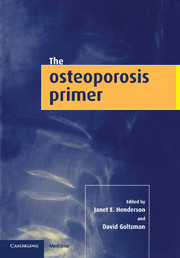Book contents
- Frontmatter
- Contents
- List of contributors
- Preface
- Part 1 Molecular and cellular environment of bone
- Part II Determinants of peak bone mass
- Part III Pathophysiology of the aging skeleton
- Part IV Clinical aspects of osteoporosis
- 17 Biochemical markers of bone turnover
- 18 Radiologic assessment of osteoporosis
- 19 Bone mineral density measurements
- 20 Hormone replacement therapy
- 21 Selective estrogen receptor modulators
- 22 Bisphosphonate therapy of osteoporosis
- 23 The action of fluoride on bone
- 24 PTH peptides as anabolic agents in bone
- 25 Vitamin D and vitamin D analogs as therapeutic agents
- Index
19 - Bone mineral density measurements
Published online by Cambridge University Press: 01 June 2011
- Frontmatter
- Contents
- List of contributors
- Preface
- Part 1 Molecular and cellular environment of bone
- Part II Determinants of peak bone mass
- Part III Pathophysiology of the aging skeleton
- Part IV Clinical aspects of osteoporosis
- 17 Biochemical markers of bone turnover
- 18 Radiologic assessment of osteoporosis
- 19 Bone mineral density measurements
- 20 Hormone replacement therapy
- 21 Selective estrogen receptor modulators
- 22 Bisphosphonate therapy of osteoporosis
- 23 The action of fluoride on bone
- 24 PTH peptides as anabolic agents in bone
- 25 Vitamin D and vitamin D analogs as therapeutic agents
- Index
Summary
Bone densitometry is accepted as a useful quantitative measurement technique for assessing skeletal status (Miller et al., 1996) and predicting the risk of fragility fractures. Low bone mineral density (BMD) is the most important risk factor for fracture. BMD testing is an objective measurement supported by extensive data showing that low bone mass and future fracture risk are inversely related. Low bone mass is as valuable a predictor of fracture as high cholesterol or high blood pressure are as predictors of their respective clinical outcomes of myocardial infarction and stroke (The WHO Study Group, 1994). Historical risk factors cannot identify the individual patient with low bone mass with adequate certainty (Pouilles et al., 1991). This does not discount the importance of assessing other risk factors for fracture. In conjunction with BMD, risk factors add valuable information required for decisions related to which patients should be treated. Also, some risk factors can be modified to help reduce fracture risk (Cummings, 1996). This is particularly true in the perimenopausal population, or in patients with secondary conditions associated with bone loss.
Diagnosis of osteoporosis using bone densitometry: the WHO criteria
In order for bone densitometry to be utilized for the purpose of identifying asymptomatic individuals at risk for fracture, a paradigm shift in the definition of osteoporosis had to occur.
- Type
- Chapter
- Information
- The Osteoporosis Primer , pp. 262 - 276Publisher: Cambridge University PressPrint publication year: 2000
- 4
- Cited by

